With the launch of the latest Intel Xeon Scalable processors (previously code-named “Cascade Lake SP”), a new standard is set for high performance computing hardware. These latest Xeon CPUs bring increased core counts, faster memory, and faster clock speeds. They are compatible with the existing workstation and server platforms that have been shipping since mid-2017. Starting today, Microway is shipping these new CPUs across our entire line of turn-key Xeon workstations, systems, and clusters.
Important changes in Intel Xeon Scalable “Cascade Lake SP” Processors include:
- Higher CPU core counts for many SKUs in the product stack
- Improved CPU clock speeds (with Turbo Boost up to 4.4GHz)
- Introduction of the new AVX-512 VNNI instruction for Intel Deep Learning Boost (VNNI)
provides significant, more efficient deep learning inference acceleration - Higher memory capacity & performance:
- Most CPU models provide increased memory speeds
- Support for DDR4 memory speeds up to 2933MHz
- Large-memory capabilities with Intel Optane DC Persistent Memory
- Support for up to 4.5TB-per-socket system memory
- Integrated hardware-based security mitigations against side-channel attacks
More for Your Dollar: performance uplift
With an increase in core counts, clock speeds, and memory speeds, applications will achieve better performance across the board. Particularly in the lower-end Xeon 4200- and 5200-series CPUs, the cost-effectiveness of the processors has increased considerably. The plot below compares the price of each processor against its performance. Both the current “Cascade Lake CP” and previous-generation “Skylake-SP” are shown:
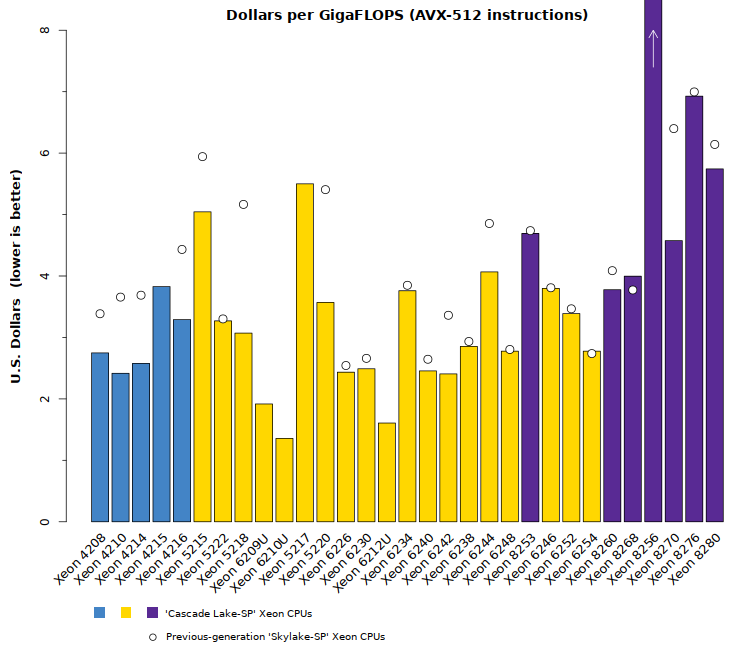
In the diagram above, the wide colored bars indicate the price performance of these new Xeon CPUs. The dots indicate the price performance of the previous generation, which allows us to compare the two generations SKU by SKU (though a few of the newer models do not have previous-generation counterparts). In this comparison, lower values are better and indicate a higher quantity of computation per dollar spent.
Same SKU – More Performance
As shown above, many models offer more performance than their previous-generation counterpart. Here we highlight models which are showing particularly substantial improvements:
- Xeon 4210 is 34% more price-performant than Xeon 4110
- Xeon 4214 is 30% more price-performant than Xeon 4114
- Xeon 4216 is 25% more price-performant than Xeon 4116
- Xeon 5218 is 40% more price-performant than Xeon 5118
- Xeon 5220 is 34% more price-performant than Xeon 5120
- Xeon 6242 saw an 8% increase in clock speed and ~10% reduction in price
- Xeon 8270 is 28% more price-performant than Xeon 8170
To summarize: this latest generation will provide more performance for the same cost if you stick with the model numbers you’ve been using. In the next section, we’ll review opportunities for cost reduction.
More for Less: Select a more modest Cascade Lake SKU for the same core count or performance
With generational improvements, it’s not unusual for a new CPU to replace a higher-end version of the older generation. There are many cases where this is true in the Cascade Lake Xeon CPUs, so be sure to consider if you can leverage such savings.
Guaranteed savings
- Xeon 4208 replaces the Xeon 4110: providing the same 8 cores for a lower price
- Xeon 4210 replaces the Xeon 4114: providing the same 10 cores for a lower price
- Xeon 4214 surpasses the Xeon 4116: providing the same 12 cores at higher clock speeds
- Xeon 5218 surpasses the Xeon 5120: providing more cores, higher clock speeds, and faster memory speeds
Worthy of consideration
- Xeon 4216 may replace most of the 5100-series: Xeon 5115, 5118 and 5120
Nearly all specifications are equivalent, but the UPI speed of the Xeon 4216 is 9.6GT/s rather than 10.4GT/s - Xeon 6230 likely replaces the Xeon 6130, 6138, 6140: providing the same or more cores for a lower price
- Xeon 6240 competes with every Xeon 6100-series model
with the exception that it does not provide 3+GHz processor frequencies
Greater Memory Bandwidth
For computationally-intensive applications, rapid access to data is critical. Thus, memory speed increases are valuable improvements. This generation of CPUs brings a 10% improvement to the Xeon 5200-series (2666MHz; up from 2400MHz) and the Xeon 6200-/8200-series (2933MHz; up from 2666MHz). This means that the Xeon 5200-series CPUs are more competitive (they’re running memory at the same speed as last generation’s Xeon 6100- and 8100-series processors). And the higher-end Xeon 6200-/8200-series CPUs have a 10% memory performance advantage over all others.
While a 10% improvement may seem to be only a modest improvement, keep in mind that it’s essentially a free upgrade. Combined with the other features and improvements discussed above, you can be confident you’re making the right choice by upgrading to these newest Intel Xeon Scalable CPUs.
Enabling Very Large Memory Capacity
With the official launch of Intel Optane DC Persistent Memory, it is now possible to deploy systems with multiple terabytes of system memory. Well-equipped systems provide each Xeon CPU with six Optane memory modules (alongside six standard memory modules). This results in up to 3TB of Optane memory and 1.5TB of standard DRAM per CPU! Look for more information on these possibilities as HPC sites begin adopting and exploring this new technology.
Transitioning from the “Skylake-SP” Intel Xeon Scalable CPUs
Because the new “Cascade Lake SP” CPUs are socket-compatible with the previous-generation “Skylake SP” CPUs, the upgrade path is simple. All existing platforms that support the earlier CPUs can also accept these new CPUs. This also simplifies the choice for those considering a new system: the new CPUs use existing, proven platforms. There’s little risk in selecting the latest and highest-performance components. HPC sites adding to existing clusters will find they have a choice: spend the same for increased performance or spend less for the same performance. Below are peak performance comparisons of the previous generation CPUs with the new generation:
Performance for applications with AVX-512 instructions
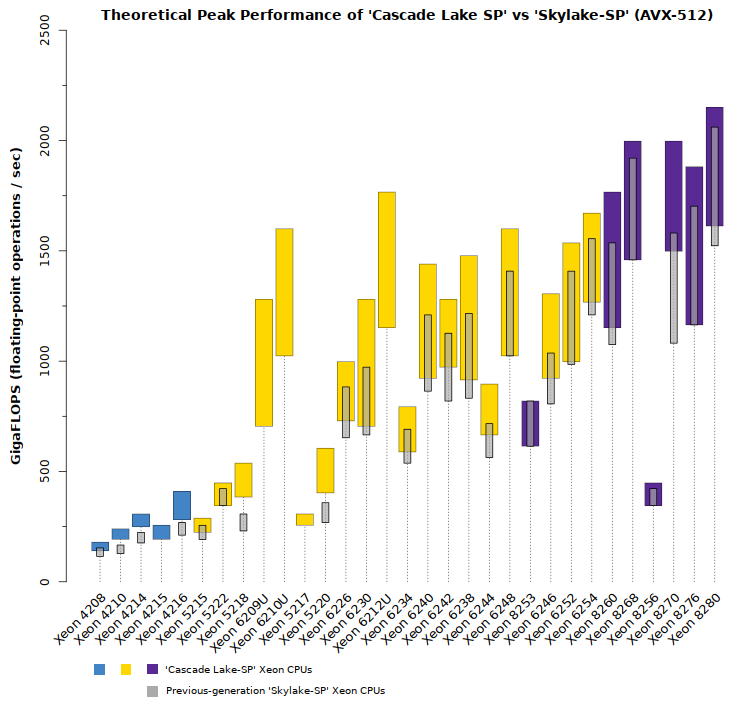
Performance for applications with AVX2 instructions
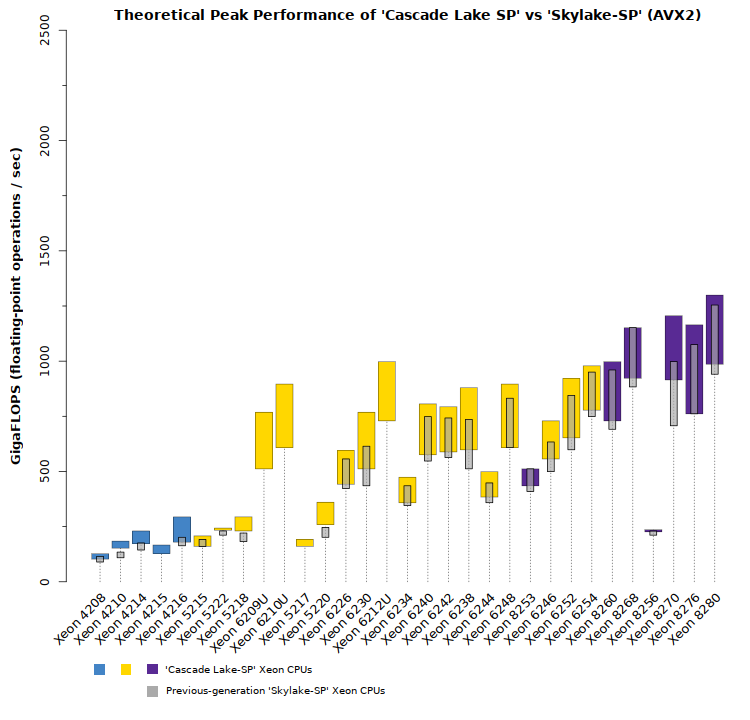
Standout performance in a single socket
This generation introduces three CPU models designed for single-socket systems (providing very high throughput at relatively low-cost). They provide 20+ CPU cores at prices as much as $2,000 less than their multi-socket counterparts. If your workload performs well with a single CPU, these SKUs will be incredibly valuable:
- Xeon 6209U outperforms nearly all of last generation’s Xeon Gold 6100-series CPUs
- Xeon 6210U outperforms all Xeon 6100-series and many 6200-series CPUs
- Xeon 6212U outperforms several of the Xeon 8100-series CPUs
The only exception to the above would be for applications which require very high clock speeds, as these single-socket CPU models do not provide base processor frequencies higher than 2.5GHz. The strength of these single-socket processors is in high throughput (via high core count) and decent clock speeds.
Next Steps: get started today!
Read More
If you’d like to read more about these new processors, check out our article with detailed specifications of the Intel Xeon “Cascade Lake SP” CPUs. We summarize and compare the specifications of each model, and provide guidance on which models are likely to be best suited to computationally-intensive HPC & Deep Learning applications.
Try Intel Xeon Scalable CPUs for Yourself
Groups which prefer to verify performance before making a design are encouraged to sign up for a Test Drive, which will provide you with access to bare-metal hardware with Intel Xeon Scalable CPUs, large-memory, and more.
Speak with an Expert
If you’re expecting to be upgrading or deploying new systems in the coming months, our experts would be happy to help you consider your options and design a custom cluster optimized to your workloads. We also help groups writing budget proposals to ensure they’re requesting the correct resources. Please get in touch!

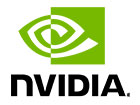
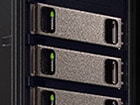
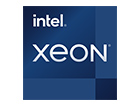
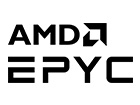

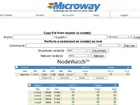








Pingback: Microway Boosts Solutions with 2nd Generation Intel Xeon Scalable Processors